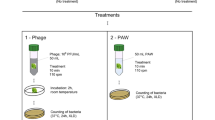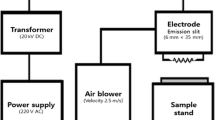Abstract
The aim of this study was to examine the effectiveness of plasma-activated water (PAW) for inactivating Pseudomonas deceptionensis CM2 on chicken breasts. Sterile distilled water (SDW) was activated by gliding arc discharge plasma for 60 s, which was defined as PAW60. The chicken breast samples inoculated P. deceptionensis CM2 were dipped in PAW60 or SDW for the indicated time intervals, respectively. After the treatment of PAW60 for 12 min, the population of P. deceptionensis CM2 on chicken breast was significantly reduced by 1.05 log10 CFU/g (p < 0.05), which was higher than that of SDW-treated samples for the same time intervals (p < 0.05). The L* value of chicken breasts were increased whereas a* and b* values were decreased following PAW60 treatment, while there was no significant differences in the values of a* and b* between PAW60- and SDW-treated samples for the same time intervals (p > 0.05). As compared with SDW, PAW60 caused no significant changes in the texture characteristics (e.g. hardness, springiness, cohesiveness and gumminess) and sensory properties (e.g. appearance, color, odor, texture, acceptability). Thus, PAW can be very effective to improve microbiological safety of chicken breasts with resulting slight changes to the sensory qualities. This synergistic treatment of PAW with other non-thermal technologies should be well investigated in order to improve inactivation efficacy of PAW.


Similar content being viewed by others
References
Arjunan KP, Sharma VK, Ptasinska S (2015) Effects of atmospheric pressure plasmas on isolated and cellular DNA—a review. Int J Mol Sci 16(2):2971–3016
Bhat ZF, Morton JD, Mason SL, Bekhit AEA (2019) Current and future prospects for the use of pulsed electric field in the meat industry. Crit Rev Food Sci Nutr 59(10):1660–1674
Borch E, Kant-Muermans ML, Blixt Y (1996) Bacterial spoilage of meat and cured meat products. Int J Food Microbiol 33(1):103–120
Choi S, Puligundla P, Mok C (2016) Corona discharge plasma jet for inactivation of Escherichia coli O157:H7 and Listeria monocytogenes on inoculated pork and its impact on meat quality attributes. Ann Microbiol 66(2):685–694
De Halleux D, Piette G, Buteau ML, Dostie M (2005) Ohmic cooking of processed meats: energy evaluation and food safety considerations. Can Biosyst Eng 47:341–347
Doulgeraki AI, Ercolini D, Villani F, Nychas GJE (2012) Spoilage microbiota associated to the storage of raw meat in different conditions. Int J Food Microbiol 157(2):130–141
Duan DB, Wang HH, Xue SW et al (2017) Application of disinfectant sprays after chilling to reduce the initial microbial load and extend the shelf-life of chilled chicken carcasses. Food Control 75:70–77
Fröhling A, Durek J, Schnabel U et al (2012) Indirect plasma treatment of fresh pork: decontamination efficiency and effects on quality attributes. Innov Food Sci Emerg Technol 16:381–390
Guo J, Huang K, Wang X et al (2017) Inactivation of Yeast on grapes by plasma-activated water and its effects on quality attributes. J Food Prot 80(2):225–230
Huff-Lonergan E, Lonergan SM (2005) Mechanisms of water-holding capacity of meat: the role of postmortem biochemical and structural changes. Meat Sci 71(1):194–204
Ismail I, Joo ST (2017) Poultry meat quality in relation to muscle growth and muscle fiber characteristics. Korean J Food Sci Anim Resour 37(6):873–883
Jayasena DD, Kim HJ, Yong HI et al (2015) Flexible thin-layer dielectric barrier discharge plasma treatment of pork butt and beef loin: effects on pathogen inactivation and meat-quality attributes. Food Microbiol 46:51–57
Jung S, Kim HJ, Park S et al (2015) The use of atmospheric pressure plasma-treated water as a source of nitrite for emulsion-type sausage. Meat Sci 108:132–137
Jung S, Lee J, Lim Y et al (2017) Direct infusion of nitrite into meat batter by atmospheric pressure plasma treatment. Innov Food Sci Emerg Technol 39:113–118
Kim HJ, Sung NY, Yong HI et al (2016) Mutagenicity and immune toxicity of emulsion-type sausage cured with plasma-treated water. Food Sci Anim Resour 36(4):494–498
Koszucka A, Nowak A (2018) Thermal processing food-related toxicants: a review. Crit Rev Food Sci Nutr. https://doi.org/10.1080/10408398.2018.1500440
Lee H, Yong HI, Kim HJ et al (2016) Evaluation of the microbiological safety, quality changes, and genotoxicity of chicken breast treated with flexible thin-layer dielectric barrier discharge plasma. Food Sci Biotechnol 25(4):1189–1195
Liao XY, Su Y, Liu DH et al (2018) Application of atmospheric cold plasma-activated water (PAW) ice for preservation of shrimps (Metapenaeus ensis). Food Control 94:307–314
Ma RN, Yu S, Tian Y et al (2016) Effect of non-thermal plasma-activated water on fruit decay and quality in postharvest Chinese Bayberries. Food Bioprocess Technol 9(11):1825–1834
Naïtali M, Kamgang-Youbi G, Herry JM et al (2010) Combined effects of long-living chemical species during microbial inactivation using atmospheric plasma-treated water. Appl Environ Microbiol 76:7662–7664
Omer MK, Alvarez-Ordonez A, Prieto M et al (2018) A systematic review of bacterial foodborne outbreaks related to red meat and meat products. Foodborne Pathog Dis 15(10):598–611
Rahman SME, Wang J, Oh DH (2013) Synergistic effect of low concentration electrolyzed water and calcium lactate to ensure microbial safety, shelf life and sensory quality of fresh pork. Food Control 30(1):176–183
Remenant B, Jaffres E, Dousset X et al (2017) Bacterial spoilers of food: behavior, fitness and functional properties. Food Microbiol 45(PrA):45–53
Shen J, Tian Y, Li YL et al (2016) Bactericidal effects against S. aureus and physicochemical properties of plasma activated water stored at different temperatures. Sci Rep 6:28505
Shimamura Y, Shinke M, Hiraishi M et al (2016) The application of alkaline and acidic electrolyzed water in the sterilization of chicken breasts and beef liver. Food Sci Nutr 4(3):431–440
van Boekel M, Fogliano V, Pellegrini N et al (2010) A review on the beneficial aspects of food processing. Mol Nutr Food Res 54(9):1215–1247
Xiang QS, Kang CD, Niu LY et al (2018a) Antibacterial activity and a membrane damage mechanism of plasma-activated water against Pseudomonas deceptionensis CM2. LWT Food Sci Technol 96:395–401
Xiang QS, Liu XF, Li JG et al (2018b) Influences of cold atmospheric plasma on microbial safety, physicochemical and sensorial qualities of meat products. J Food Sci Technol 55(3):846–857
Xiang QS, Kang CD, Zhao DB et al (2019a) Influence of organic matters on the inactivation efficacy of plasma-activated water against E. coli O157:H7 and S. aureus. Food Control 99:28–33
Xiang QS, Liu XF, Liu SN et al (2019b) Effect of plasma-activated water on microbial quality and physicochemical characteristics of mung bean sprouts. Innov Food Sci Emerg Technol 52:49–56
Xu YY, Tian Y, Ma RN et al (2016) Effect of plasma activated water on the postharvest quality of button mushrooms, Agaricus bisporus. Food Chem 197(PtA):436–444
Yang TS, Froning GW (1992) Selected washing processes affect thermal gelation properties and microstructure of mechanically deboned chicken meat. J Food Sci 57(2):325–326
Yang S, Sadekuzzaman M, Ha SD (2017) Treatment with lauric arginate ethyl ester and commercial bacteriophage, alone or in combination, inhibits Listeria monocytogenes in chicken breast tissue. Food Control 78:57–63
Yong HI, Lee H, Park S et al (2017) Flexible thin-layer plasma inactivation of bacteria and mold survival in beef jerky packaging and its effects on the meat’s physicochemical properties. Meat Sci 123:151–156
Yong HI, Park J, Kim HJ et al (2018) An innovative curing process with plasma-treated water for production of loin ham and for its quality and safety. Plasma Process Polym 15(2):e1700050
Zhou GH, Xu XL, Liu Y (2010) Preservation technologies for fresh meat-a review. Meat Sci 86(1):119–128
Acknowledgements
This work was financially supported by the National Key R & D Program of China (No. 2018YFD0401204), the China Postdoctoral Science Foundation (No. 2018M632765), the Fundamental Research Funds for the Universities in Henna Province (No. 18KYYWF0404), and the Foundation for University Young Key Teachers of Henan Province (No. 2017GGJS095).
Author information
Authors and Affiliations
Corresponding author
Ethics declarations
Conflict of interest
The authors declare that they have no conflict of interest.
Additional information
Publisher's Note
Springer Nature remains neutral with regard to jurisdictional claims in published maps and institutional affiliations.
Rights and permissions
About this article
Cite this article
Kang, C., Xiang, Q., Zhao, D. et al. Inactivation of Pseudomonas deceptionensis CM2 on chicken breasts using plasma-activated water. J Food Sci Technol 56, 4938–4945 (2019). https://doi.org/10.1007/s13197-019-03964-7
Revised:
Accepted:
Published:
Issue Date:
DOI: https://doi.org/10.1007/s13197-019-03964-7




